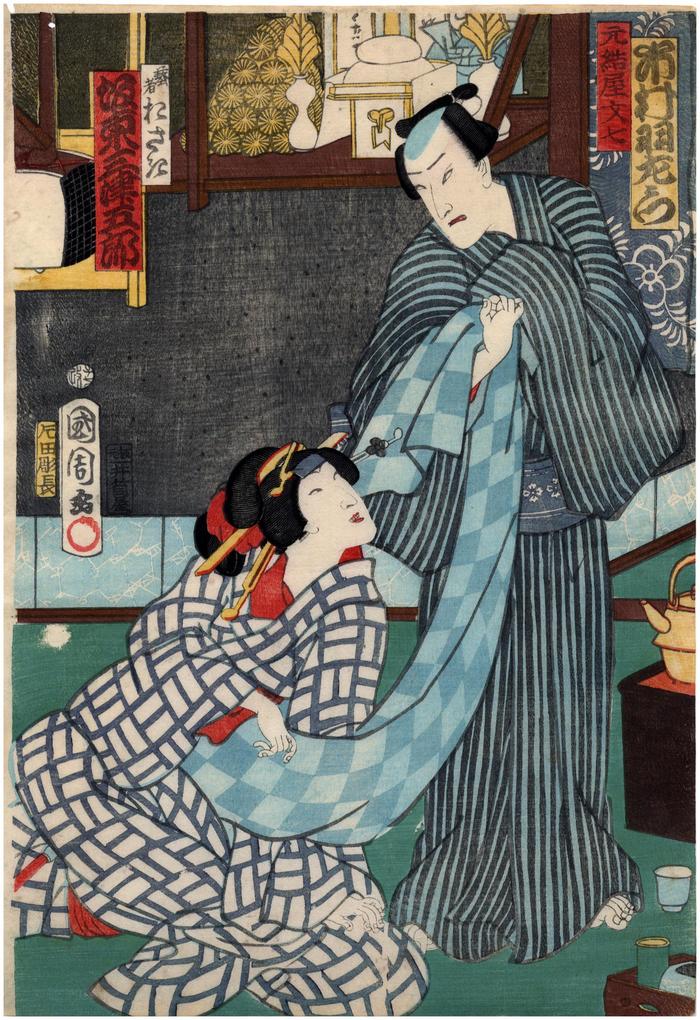Toyohara Kunichika (豊原国周) (artist 1835 – 1900)
Ichimura Uzaemon XIII (市村 羽左衛門) as motoyiya Bunshichi (元結屋文七) and Bandō Mitsugorō VI (坂東三津五郎) as the geisha Osaki (芸者おさき)
07/1864
9.75 in x 14.25 ft (Overall dimensions) color woodblock print
Signed: Kunichika ga (国周画)
Publisher: Izutsuya Shōkichi (Marks 188 - seal 24-055) Carver: Katada Hori Chō
Date seal: 1864, 7th month
Japan Arts Council
Museum of Fine Arts, Boston - an 18th c. print by Tori Kiyomasu I of Bunshichi Motoyui
Kabuki21 - summary of a play based on this theme
Museum of Oriental Art, Venice (via Ritsumeikan University) A motoyui is a paper strip used to tie off the hair. While this print is dated from 1864 there is a play that must be connected with the story behind this print. The play was first performed in 1902 and is called Ninjō Banashi Bunshichi Motoyoui. Click on the link to Kabuki21 to see a summary of that play.
One should also note that based on this print by Kunichika and the one by Kiyomasu print linked above which comes from the 18th century, both of which feature 'Bunshichi Motoyui,' must come from a related but unrecorded earlier play or plays.
****
We have searched and searched for references to a play about this character from the time of this print and have found nothing. What we did find was a triptych in the Museum of Fine Arts in Boston by Kunisada II created at the same time. This would definitely point toward a specific play, but so far we don't know what it is. Then we noticed that the link added above to Japan Arts Council states in translation: "There is currently no record of performances in the era of the change of seal." A change seal is the same thing as a date seal.
Perhaps we will never know, but the search is still worth pursuing.
****
A talented geisha is one who can perform on the shamisen well. On the shelf in the upper left of this print is a partial view of her instrument. Look for the white kawa or skin. Slightly higher and more toward the center in the back is the household altar with its mochi or two-tiered, sticky rice cake on a ceremonial stand, two saké containers - one representing the male and the other the female - and a memorial portrait of a revered ancestor.
****
It should be noted that in a lecture, 'The Poetics of Inscribed Kabuki Actor Prints', viewable on YouTube, by John T. Carpenter said that the three-string shamisen was "the most common instrument of the Yoshiwara brothels as well as kabuki and among geisha."
actor prints (yakusha-e - 役者絵) (genre)
Izutsuya Shōkichi (井筒屋庄吉) (publisher)
Ichimura Uzaemon XIII (十三代目市村羽左衛門: 1/1851 to 1862) (actor)
Bandō Mitsugorō VI (六代目坂東三津五郎: 5/1856 to 9/11/1873) (actor)
Katada Chōjirō (片田長次郎) (carver)
